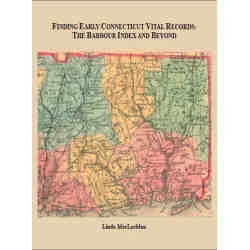
[av_image src=’https://genealogical.com/wp-content/uploads/2018/04/2018-04-17-04-50-20.68983f8c735befefac2d9e1371afd616db38c7d6-223×300.jpg’ attachment=’4691′ attachment_size=’medium’ align=’right’ styling=” hover=’av-hover-grow’ link=’manually,https://library.genealogical.com/printpurchase/Xeger’ target=’_blank’ caption=’yes’ font_size=’18’ appearance=’on-hover’ overlay_opacity=’0.4′ overlay_color=’#000000′ overlay_text_color=’#ffffff’ animation=’no-animation’ admin_preview_bg=” av_uid=’av-3malvw’]
View Book Details
[/av_image]
Many genealogists hope one day to gain membership in a hereditary or lineage society, such as the Sons of the American Revolution, or the 17th Century Colonial Dames of America. For these individuals, one of the many virtues of the new book, Professional Genealogy: Preparation, Practice, and Standards (Progen PPS), edited by Elizabeth Shown Mills, can be found in Chapter 17, “Lineage Applications.” . While the requirements for lineage society membership vary by the organization, Chapter 17’s authors, Barbara J. Matthews and Darcie Hind Posz, nonetheless, provide researchers with a huge leg up on the qualification process. To illustrate, we have excerpted the following section on “Meeting Requirements of Lineage & Heraldic Societies.”
MEETING REQUIREMENTS OF LINEAGE & HERALDIC SOCIETIES
While each society has its own requirements, our first step toward preparing an application is always the same. We should obtain and completely read the guidelines or rules of that particular society. Failure to do so will set us up for a fall-or at least for a letter from the qualifying genealogist requesting a formatting correction (usually for lineage or citation issues) or additional documentation to meet requirements.
We should also obtain a blank copy of the lineage application and study the layout. Some forms begin with the applicant as the first generation, while other forms have the qualifying ancestor as Generation One. We read through all portions of the blank form. Typically, there will be three sections: the lineage section, the qualifying-service section, and the sourcing or documentation section.
As we proceed, we should feel free to ask questions that arise. Some societies have study groups, web pages for queries, and courses to assist current and prospective members. Most societies have published their guidelines. For instance, the website of the National Society, Daughters of the American Revolution (DAR) offers “Is That Service Right?” and” Is That Lineage Right?” Both publications assist candidates and registrars in preparing applications to meet lineage and service requirements.
Whether we are preparing an application for ourselves or for a client, our own standards, ethics, and professionalism should be consistent. For this reason, we keep the manual Genealogy Standards front-and-center in our work, in addition to the society’s own set of rules. Genealogy standard number 68 explicitly states, “Applications for lineage-society membership adhere to the society’s instructions .”
You will also need to identify a “qualifying” ancestor. Most lineage groups have printed publications that list eligible men and women-often with personal information such as year and location of birth and death, identity of spouse, service, and place of residence at time of service. The DAR website also offers a database, the “Genealogical Research System (GRS),” that is updated daily as new information is obtained through verifying applications. (Prior to the creation of this database, researchers used the published D.A.R. Patriot Index that you will see cited on many earlier applications ; this three-volume set was updated several times during its publication cycle.) The modern database gives researchers easy access to the most recent information on qualifying ancestors, errors in previously accepted lineages, common ancestors within a lineage, residences, service details, and source citations. For other societies, printed publications listing eligible ancestors frequently can be found on the society’s website, in the reference sections of local libraries, at websites that digitize books, or by asking a local chapter or registrar affiliated with the society.
If the targeted ancestor has not been previously approved, you will have to establish the eligibility. Service requirements range from society to society. As examples: proved presence as a Mayflower passenger; military service during a specific war or a certain military rank; civil or patriotic service as a minister, an oath-taker, or a refugee; land ownership or a specific occupation; royal status or presence on a Native American roll.
Once you have determined what form of service a particular society requires for a qualifying ancestor, the accuracy of service should be verified with the best available resources. Often, the National Archives or the relevant state archives will have the original military-service records. If those are faded or fragile, there may be published transcriptions to document both military and patriotic service. County courthouses often hold records relating to civil service, some patriotic service, and land ownership. These local records may also be available in imaged form through FamilySearch, Salt Lake City’s Family History Library, or one of the latter’s local Family History Centers. For qualifying service within royal lineages, the National Archives in the United Kingdom holds the Inquisitions Post Mortem , in both original and published format. A second essential source, the 1530- 1668 Heraldic Visitations, organized by county, are also published.
When multiple people of the same name exist during a specific period, we must clearly establish the residence and identity of the qualifying person (see subsequent “Standards for identification”). Thorough use of court records, gazetteers, land grants and deeds, and tax rolls is essential for both purposes; and evidence can be drawn from these records in creative ways. As a case in point: There may be several John Smiths in a particular county. If, say, a land entry can be correlated with a juror summons and the birth of a child that is noted in a church record, it not only confirms a connection between father and child, but it also establishes that the man was old enough to perform civil service and possess the land that establishes residence for his place and time.
[av_button label=’View ProGen PPS Book Now’ link=’manually,https://library.genealogical.com/printpurchase/Xeger’ link_target=’_blank’ size=’large’ position=’center’ icon_select=’yes’ icon=’ue84f’ font=’entypo-fontello’ color=’theme-color’ custom_bg=’#444444′ custom_font=’#ffffff’ admin_preview_bg=” av_uid=’av-2mtlnw’]
Have questions about ProGen PPS, Lineage Applications, and/or Guidelines for Achieving Lineage Membership / Guidelines Hereditary Society Membership? Please leave them in the comments section below!




